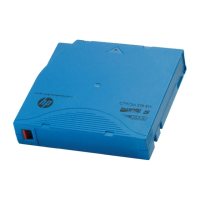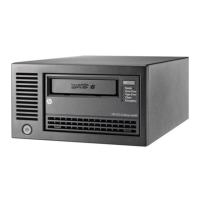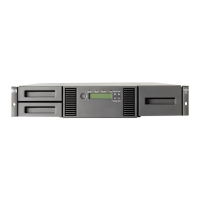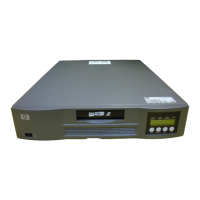Conditions in storage
LTO Ultrium cartridges will preserve the integrity of stored data for up to 30 years if proper storage
conditions are observed.
• For short-term storage, keep cartridges at temperatures between 16°C and 32°C (61°F and 90°F)
with a relative humidity between 20% and 80%.
• For long-term archival storage, keep cartridges between 5°C and 23˚°C (41°F and 73°F) with a
relative humidity between 20% and 60%. Wet bulb temperature should not exceed 26°C (78°F).
• Always keep the cartridges in a clean environment.
• Always store cartridges in their plastic cases on their side when not in use.
Maximizing tape life
• Do not touch the tape surface.
• Do not attempt to clean the tape path or tape guides inside the cartridge.
• Do not leave cartridges in excessively dry or humid conditions.
• Do not leave cartridges in direct sunlight or in places where magnetic fields are present (for ex-
ample, under telephones, next to monitors or near transformers).
• Do not drop cartridges or handle them roughly.
• Stick labels onto the label area only.
LTO Cartridge Memory
Linear Tape Open—Cartridge Memory (LTO-CM) is an EEPROM that is embedded in every LTO
Ultrium tape cartridge. It is non-volatile and is contactless in that it is read by inductive coupling rather
than electrical contact.
The Cartridge Memory is used to store the tape directory and diagnostic and log information. Because
of the speed at which it can be read, load and unload times are reduced, information is found on
the tape more quickly and fewer tape passes are needed, increasing tape reliability.
The memory is primarily designed to speed up internal operations in the drive, but it also contains
free space that can be used by application software. This may be used to store “common” information
(shared by all software vendors) and “vendor-unique” information (specific to the application).
Hosts can use this free space using the SCSI Write Attribute and Read Attribute commands. For
information on these commands, see Chapter 4 of theHost Interface Guide, Volume 3 of this HP LTO
Ultrium Technical Reference Manual.
To support CM fully, software vendors should ensure that their company names are registered with
ANSI T10 or the National Committee for Information Technology Standards (NCITS) as they are now
known. The list of Vendor IDs is displayed at http://www.t10.org/lists/vid-alph.htm, which also
contains details of how to get a new name assigned.
Cartridge Memory adheres to the Media Auxiliary Memory (MAM) standard. “MAM” indicates that
the access method applies to all types of media, not just LTO Ultrium.
The MAM standard provides for the storage and access of information held as a set of pre-defined
and user-definable attributes that are divided into six main sections:
• Media Common Section—hard-coded by the media manufacturer. For example: manufacturer’s
name, cartridge serial number, length, media type
• Drive Common Section—updated by the drive every time it accesses the media. For example:
maximum and remaining tape capacity, TapeAlert flags
Volume 1: hardware integration 45

